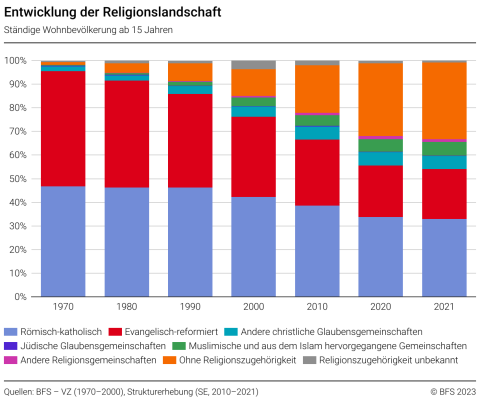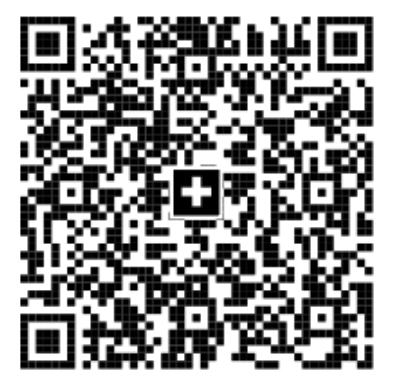No special rights for religious communities
Since last year, non-denominational people have been the largest world-view group in Switzerland. Immigration and the increasing lack of religious affiliation, even among church members, are accelerating the trend towards secular thinking. Another major factor in this trend is the fact that most of the elderly who die were more likely to belong to religious and faith groups. It is therefore high time to bring the state on track and put an end to the countless special rights religious communities enjoy. The free-thinkers must be pacemakers and pioneers in this process.
By Andreas Kyriacou

In 2022, people with no religious affiliation were the largest single ideological group in Switzerland for the first time. In 2021, Catholics, with a share of 32.9%, were still just ahead of the non-religious with 32.3%. But the non-denominational increased by 1.4% in 2021, while the Reformed lost 0.7% and the Catholics 0.9%. This was shown by the structural survey of the Federal Statistical Office (FSO) published in January 2023. The Reformed in 2021 were at 21.1%.
The shifts are likely to have been of a similar size in 2022. If one extends the period under consideration, it becomes apparent that the trend is clear: Switzerland's population is becoming more secular year by year.
In 1970, only about 1% of the population was considered non-religious. A decade later it was 4%, in 1990 7.5% and at the turn of the millennium already over 11%. In 2010, the non-religious made up 20% of the population. By 2020, it was already a proud 30.9%. In the same period (1970 to 2020), the population share of the Reformed fell from just under 49% to 21.1% and that of the Catholics from just under 47% to 32.9%.
The other Christian denominations, which include Evangelical and Orthodox groups in particular, grew from 2% to 5.6% of the population in the same period. The proportion of Muslims also increased. In the 1990 census, they made up more than 1% for the first time; in 2021, the figure was 5.7%. The number of members of Judaism and other religious communities is stagnating. In 2021 they had a share of around 1.5%.
BfS data show: The different degrees of decline of Reformed and Catholics is primarily due to immigration. Of the current 1.7 million foreigners aged 15 and over, more than 610,000 are Catholics, but only just under 70,000 are Protestant Reformed. Only among Germans living in Switzerland is the proportion of Protestants in double figures, at just under 19%. In contrast, Catholics make up between 56% and 72% of the Spanish, Portuguese and Italians living here.
The effect of immigration
However, the migration gains are increasingly shifting in favour of the non-religious, because even in the countries from which the immigrants predominantly come from, religion is playing an increasingly minor role. As an example: In a representative survey in Spain in 2020, 30% said they were agnostic, atheist or religiously indifferent. Another 47% described themselves as non-practising Catholics. Only 20% said they practised the Catholic faith. This figure is likely to drop significantly in the coming years, as among 18 to 24 year olds it is just under 10%, while 40% of those over 64 say they are practising Catholics. In the youngest age category, 53% describe themselves as agnostic, atheist or indifferent, while in the highest it is only 11%.
More non-religious immigrants - especially from Germany
Secularisation is particularly pronounced among German immigrants. 53% of Germans living in Switzerland say they are non-religious. In Germany itself, the non-religious made up 41% of the population at the end of 2020.
The variation in the Germans living in Switzerland is probably primarily due to the higher age average: Those who emigrate are comparatively younger and thus - on average - less religious. Other BfS statistics show that Switzerland primarily attracts younger people: it is predominantly in the age groups up to 40 where net migration is positive. For the over-64s, on the other hand, return migration to the home countries is predominant. And this age group is more loyal to the church. So the Catholic Church in particular is facing a double challenge: immigrants from the classic Catholic countries of origin increasingly no longer have any connection to the church, and some of their members with a migration background are emigrating again.
Only a fraction Christian
In 2021, Switzerland had a net migration of at least 55,000 people. The EU states accounted for more than two-thirds. Immigrants from Germany, Italy and France in turn account for almost two-thirds of net immigration from the EU area. Of these three diaspora groups, however, only the Italian group is still on the whole Christian; among the Germans and French, the non-denominational are the majority. The fourth-placed Spaniards are also still mainly Christian, but they only form a congregation just under a third as large as the Germans. For the other regions with positive net migration (Balkan countries and the rest of Europe, America, Asia and Africa), the state-recognised churches can hardly improve their membership statistics through immigration. Only among Africans is the proportion of Catholics just into double figures, at 14%. Depending on the region, there are shifts primarily in favour of the non-religious, the Muslims and - due to immigration from Asia - the other religious communities.
In addition, even members of the Catholic or Reformed Church, but also those who call themselves Muslim, are to a considerable extent non-religious.
Religiously distant "believers”
This is illustrated, among other things, by an evaluation by Peter Moser of the Statistical Office of the Canton of Zurich. He classifies almost half of the Reformed and a third of the Catholics as secular on the basis of the feedback on religiosity and spirituality, as well as a third of the Muslims. Politicians should bare this in mind when they claim to champion the concerns of "the Muslims". They are just as heterogeneous a group as the Reformed or the Catholics. And just as relevant: In the canton of Zurich, according to Moser's analysis, half of the population already belonged to the secular group in 2019.
It is predictable that by the end of this decade, Switzerland will have more secular thinkers than Reformed and Catholics combined. If the de facto religious members of the churches and other religious communities are included, around two-thirds of the population will represent a clear secular majority in 2030.
A turnaround in politics is needed
Politicians are finding it difficult to react adequately to these changes. The uncritical support for the construction of barracks in the Vatican in the vast majority of cantons shows this clearly. The churches lobby skilfully and usually find compliant majorities in governments and parliaments. The most recent example: the formerly nationalised Mariastein monastery in the canton of Solothurn was returned to the monastic brothers after a referendum in 1970. The monastery had regained its freedom, said the then Landamman and later Federal Councillor Willi Ritschard. A good 50 years later, the canton is throwing 2.4 million Swiss francs at the monastery for the redesign of the forecourt, with the blessing of the government and the parliamentary majority. The canton already afforded itself a monstrosity in 2019: the reform of corporate taxes also led to a loss of revenue for the churches. But instead of reducing the costs in view of the dwindling membership figures, the churches successfully lobbied for the state, which itself had to cope with significantly lower revenues due to the tax reform, to guarantee them a fixed amount of 10 million francs, even though it was foreseeable that the income from corporate church taxes would be lower. But the injustices in tax law go much further: churches are exempt from profit taxes of all kinds in several cantons.
Religious communities are not only favoured financially. During religious education lessons in schools, the living world of non-religious children is mostly left out. There is a lack of secular alternatives to pastoral care and other counselling services, which in many places are outsourced to the churches. Several cantons give special status to religious "round tables", but exclude representations of secular-humanist worldviews.
Freethinkers as pacemakers
Last year's vote on the Lucerne state contribution to the Vatican barracks showed: Our positions are capable of gaining a majority. We have to make it clear to governments and parliaments that they have to consider us, with referenda, but also with initiatives. And we must back with our support those politicians who also want a secular Switzerland. Fortunately, they exist in almost all parties. In Lucerne and in Valais, cooperation worked excellently last year. We must have more confidence in ourselves – and do more. Let the 2020s be the decade of secularisation! Join in. The more people who actively help, the more we can achieve!
This article was published in our magazine "frei denken." in the spring edition 2023 (in German).






